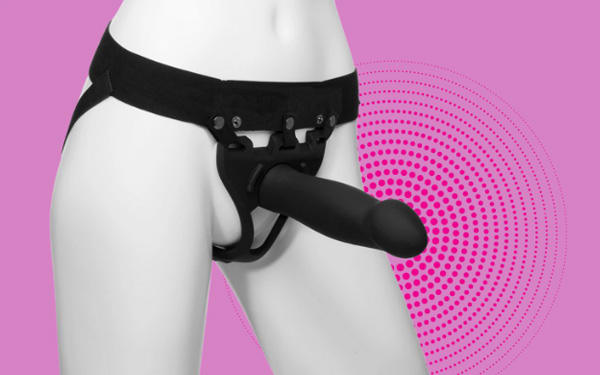Setting Safe Scenes: Safewords & Negotiation
As we all should know, consent is always a vital and necessary part of any sexual or erotic play, no matter what. An essential part of consent is being fully informed so that all participants can agree on what may happen during your scene (in BDSM, a scene refers to the entire interaction and activities that take place start to finish in an encounter).
Simply put, scene negotiation is the conversation that needs to happen before a BDSM scene begins. This is where you can discuss the details of what it is that you’re interested in exploring or taking part in, and make sure that all expectations are aligned. This is where you can (and should!) state your needs, wants, boundaries, and curiosities.
The reason why scene negotiation should happen in advance is that when we are already beginning our scene, that active adrenaline in our arousal or excitement can cause us to barrel through negotiation with a mindset that may not be as clear and sound as it could be outside of the bedroom. If we’re raring to go, we can miss important information from our partner, or not properly share our own.
While we might believe that it may not feel super sexy to have a sit-down talk with a playmate before getting down to it, this conversation will not only help to prevent any negative experiences but can also make sure that we have time to craft a scene that’s going to give everyone the best and hottest possible experience. Think of it as conversational foreplay and let that sexy anticipation build!
This is a time to set all expectations. What are you hoping this scene is going to include? Who will be involved, in what way? Will there be penetrative sex? What safer sex practices are being used? What type of toys and sensations will we be exploring??
Especially for BDSM scenes, remember: our bodies are unique and nuanced, and so how sensation is experienced can (and often does) vary from person to person (for example, what feels like a light spank to one person may be too intense for another). Beyond this, BDSM often has emotional and mental elements to it as well as physical, so don’t forget to describe how you want the scene to feel in that regard – do you want it to be sensual and caring? Do you want to play with power dynamics that may be different from how your relationship usually feels?
During scene negotiation, the more detail that’s given, the better.
Wants: This is something that has been done before that there is a firm interest in doing again.
· I want you to use a vibrator on me.
· I’d like to be your submissive during this scene.
Curiosities: This is something that hasn’t been explored yet, but there is interest in trying.
· I want to try being spanked with a firmer paddle.
· Can we try using a blindfold?
Needs: This is something that is required for participation in the scene or activity.
· If you’re going to Dominate me, I need you to give me affirmations throughout.
· I need to be tied up to get into a submissive headspace.
Hard Limit: Also known as a boundary. This is something that is off the table for this scene (or always) and is not to be engaged in during the scene in any way. If a hard limit is disregarded, it is a violation of consent.
· I have a hard limit when it comes to hair pulling.
· For this scene, I do not want to have penetrative sex – I want this to be bondage only.
Soft Limit: In contrast to a Hard Limit that must not be violated, a Soft Limit refers to an act or situation that someone might have some apprehensions towards, but which might be engaged in with careful negotiation under the right circumstances. Soft limits can also mean that the entire act is not off the table, but that there is a specific threshold to the action that needs to be acknowledged and respected. Soft limits should be discussed with as much detail as possible.
· I’m okay with being spanked, but not to the point of becoming bruised or marked. I will call my safeword if I am spanked too hard.
· I don’t necessarily like being called names in bed, but if you want to try names that are not very harsh – like “naughty” – I might be okay with that. I will say “yellow” if you call me a name I do not like, so that you know to stop.
*See below for info on safewords / “yellow” (stoplight method)
During scene negotiation, an important decision to be made is the creation of a safeword that everyone involved will be familiar with. A safeword is a word (or sound or action) that conveys that a boundary has been reached or crossed and acts to let everyone in the scene know that play needs to be paused or stopped completely.
Think of a safeword as “no,” “stop,” or “time out”. These words work as default safewords and retract consent from the action by the person who says them. However, sometimes in BDSM or kinky play, the words “no” and “stop” may come up as part of the roleplay within the scene. Setting a safeword allows the scene to include these words as a part of the roleplay.
For example, if you are playing a submissive role, you may say “No! Stop! I promise I’ve been good, don’t spank me!” in a playful way inside the fantasy of yielding control to the Dominant partner – but again, it’s a roleplay and these words are part of setting a fantasy scene.
Safewords should be easy to say and easy to recognize. This means that you want your safeword to be easy to pronounce, easy to remember, and a word that can’t be confused with anything else that may be said as part of the scene.
For example, if you are doing a pirate roleplay, “ship” may not be a distinct safeword. If your partner’s name is Joanna, “banana” may not be a clear safeword.
Make your safeword something punchy – starting with a hard consonant sound is always a good option, as our sense of hearing tends to pick up on these sounds clearly. Some ideas for safewords include pineapple, Jupiter, vanilla, ping-pong, mermaid, and the most popular: red.
Safewords can also have levels to them – a very popular way to do this is the stoplight method, in which you use the colors red and yellow to convey “stop completely,” and “slow down,” respectively. You may need to call yellow if you just need a break or to readjust something, but you aren’t looking to stop the action completely, like you would by saying red.
Having safe actions can be important as well, especially if there’s the potential during your scene for someone to be unable to clearly speak or clearly hear when a safeword is used. If you’re wearing a ball gag, if there’s loud music, if a partner may go non-verbal, if a partner is hard of hearing – these are all reasons to have a safe action in place of or in addition to a safe word. Some examples for safe actions include squeaking a toy, dropping a set of keys, tapping your partner twice (“tapping out”), or raising an open palm in a “stop” gesture.
Remember – safewords are serious and shouldn’t be thrown around as a joke or ignored for any reason. If you’re not sure if a safeword / safe action has been used – pause and check in clearly before continuing.
Consent can always be retracted and using a safeword does just that. Any play that continues after a safeword / safe action has been used is no longer consensual.
Don’t forget to consider what happens after the scene, too – and set those expectations as well. After you’re through with the scene, is there anything that you need – physically or emotionally – to recover or readjust before getting back to your day-to-day self? Maybe you need comfort after a particularly rough impact play session, maybe you like to be held or be brought water or a snack, maybe you need space.
If you know what you need, let your partner know beforehand so that they can make sure this is available for you. If you don’t know what you may need for aftercare, you can also say that – and allow yourself the space to find what you may need in the moment.















